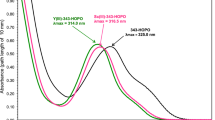Abstract
A new class of polyazamacrocyclic chelates of terbium is studied that have rich spectroscopic properties, tissue selectivity [1], millisecond fluorescence lifetimes, sharply spiked emission spectra (<15 nm FWHM), large Stokes shifts (>280 nm), good water solubility [1] and high fluorescence quantum yields (∼0.6 for PCTMB) [1]. We report our in vitro and ex vivo spectroscopic evaluation of these chelates. Additionally, results from cellular binding specificity studies using Sprague-Dawley rats with UMR 108 osteosarcomas are presented. Finally, endoscopic imaging of dosed tissue demonstrates the potential to use the Tb(III) chelates as contrast enhancement markers.
Similar content being viewed by others
References
Houlne MP, Agent TS, Kiefer GE, McMillan K, Bornhop DJ. Spectroscopic characterization and tissue imaging using site-selective polyazacyclic terbium(Ill) chelates. Appl Spectrosc 1996; 50:1221
Cotton PB. Practical Gastrointestinal Endoscopy, 3rd edn. Oxford, Boston: Blackwell Scientific, 1990
Oguro Y. Endoscopic Approaches to Cancer Diagnosis and Treatment. Tokyo: Japan Scientific Societies Press, London: Taylor & Francis, 1990
Cothren RM, Sivak Jr MV, Feld MS. Detection of dysplasia at colonoscopy using laser-induced fluorescence: a blinded study. Gastrointest Endosc 1996; 44:168
Richards-Kortum R, Rava RP, Petras RE, Fitzgerald M, Sivak M, Feld MS. Spectroscopic diagnosis of colonic dysplasia. Photochem Photobiol 1991; 53:777–86
Houlne MP, Kiefer GF, Bornhop DJ. Analytical spectroscopy of the tissue site selective lanthanide chelates, Tb-PCTMP, Tb-BP2P and Tb-PCTMB. Appl Spectrosc 1996; 10:225–44
Parker D, Gareth Williams JA. Getting excited about lanthanide complexation chemistry. J Chem Soc Dalton Trans 1996; 3613–28:
Soini E, Lougren T. Time resolved fluorescence of lanthanide probes and application in biotechnology. CRC Crit Rev Anal Chem 1987; 18:105–4
Kim WD, Kiefer GE, Maton F, McMillan K, Muller RN, Sherry AD. Relaxometry, luminescence measurements, electrophoresis and animal biodistribution of lanthanide (III) complexes of some polyazamacrocyclic acetates containing pyridine. Inorg Chem 1995; 34:2233–43
Bornhop DJ, Hubbard DS, Houlne MP, Kiefer GE, Pence B, Morgan DL. Enhanced imaging of rat colon cancer using a fluorescent. tissue site-selective metal chelate marker, Tb-PTCMB. Submitted to J Biophys Feb 1998
Houlne MP, Hubbard DS, Kiefer GE, Bornhop DJ. Imaging and quantitation of tissue selective lanthanide chelates using an endoscopic fluorometer. J Biomed Opt (To appear 1998)
Andersson-Engels S, Johansson J, Svanberg S, Svanberg K. Fluorescence diagnosis and photochemical treatment of diseased tissue using lasers: Part II. Anal Chem 1990; 62:19A-27A
Li M, Selvin PR. Luminescent polyaminocarboxylate chelates of terbium and europium: the effect of chelate structure. J Am Chem Soc 1995; 117:8132–8
Kim WD, Kiefer GE, Maton F, McMillan K, Muller RN, Sherry AD. Relaxometry, luminescence measurements, electrophoresis and animal biodistribution of lanthanide (III) complexes of some polyazamacrocyclic acetates containing pyridine. Inorg Chem 1995; 34:2233–43
Cahceris WP, Nickel SK, Sherry DA. Thermodynamic study of lanthanide complexes of 1,4,7-triazaclononane-N,N′,N″-triacetic acid and 1,4,7,10tetraazacylcododecane-N′,N″,M″′-tetraacetic acid. Inorg Chem 1987; 26:958–60
Lamture JB, Iverson B, Hogan ME. An intensely luminescent polymeric lanthanide chelator for multiple fluorescence labeling of biomolecules. Tet Let 1996; 37:6483–6
Aime S, Botta M, Sisti M. MRI contrast, agents: macrocyclic lanthanide (III) complexes with improved relaxation efficiency. J Chem Soc Chem Commun 1995; 18:1885–6
Geraldes CFGC, Sherry AD, Lazar I et al. Relaxometry, animal biodistribution, and magnetic resonance imaging studies of some new gadolinium (III) macrocyclic phosphinate and phosphonate monoester complexes. Magn Reson Med 1993; 30:696–703
Strickland R, Kiefer GE. Personal communication, Designed Chemical Group, The Dow, Chemical Company, 1995
Pertoft H, Laurent TC. In: Castimpoolas C. (ed) Methods of Cell Separations. New York: Plenum Press, 1990; 25
Menzel ER. Laser Spectroscopy: Techniques and Applications. New York: Marcel Dekker
Jain RK. Delivery of novel therapeutics agents in tumors: physiological barriers and strategies. J Natl Cancer Inst 1989; 81:570–6
Author information
Authors and Affiliations
Corresponding author
Rights and permissions
About this article
Cite this article
Hubbard, D.S., Houlne, M.P., Kiefer, G. et al. Diagnostic imaging using rare-earth chelates. Laser Med Sci 13, 14–21 (1998). https://doi.org/10.1007/BF00592956
Received:
Accepted:
Issue Date:
DOI: https://doi.org/10.1007/BF00592956



